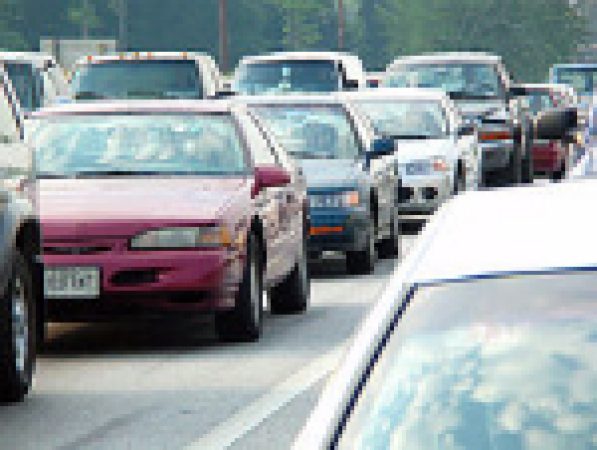Some years ago, Anthony Downs of the Brookings Institution postulated that adding capacity to a congested highway leads to a “triple convergence” of responses: some drivers shift from other roads, some drivers shift from other times of day, and some commuters shift from other modes. The predictable result is that after some time interval, the expanded highway ends up just as congested as before. This has been called the “iron law of highway congestion,” and anti-highway groups have used it as a reason to lobby against adding capacity, especially to congested urban freeways.
In 2011 the American Economic Review published a quantitative analysis of this phenomenon by Gilles Duranton and Matthew Turner (hereafter, D&T), titled “The Fundamental Law of Road Congestion: Evidence from U.S. Cities.” Using FHWA highway statistics data and National Household Travel Survey data, their econometric analysis found evidence that vehicle miles of travel (VMT) on urban Interstates increase proportionally to highway capacity. In effect, they claimed, highway supply creates its own demand.
For some reason, last month a free-market think tank (PERC) reprinted a 2011 blog post by Tanya Snyder of Streetsblog based on the D&T paper, called “Building Roads to Cure Congestion Is an Exercise in Futility.” Like a 2011 Wired article about the D&T paper, it claimed stronger results than D&T’s analysis produced—a purported one-for-one correlation (always and everywhere) between highway capacity growth and VMT growth. That post was widely circulated just about the time that the long-planned, billion-dollar northbound HOV lane addition on I-405 through the Sepulveda Pass in Los Angeles opened to traffic. And when first-month, before-and-after traffic comparisons showed negligible changes in rush-hour travel speeds on that stretch of the 405 (even though the duration of the peak period was shortened), the anti-auto, anti-highway crowd declared that outcome a vindication of D&T. As Joseph Stromberg wrote in a post on Vox.com (Oct. 23): “The ‘fundamental rule’ of traffic: building new roads just makes people drive more.”
I re-read the D&T paper last month, and as I did in 2011, found a number of problems with their analysis. First, their detailed analysis is for urban Interstates only; analytically, they treat arterials and all other roadways as a large blob. That leaves them unable to analyze (as opposed to only speculating about) the extent to which drivers shift trips from parallel arterials to the newly expanded urban Interstate (which would not represent new driving).
Second, D&T’s premise that all such freeways have a “natural level of saturation” implies that all urban Interstates should fill up to the point of serious peak-period congestion. But in fact, actual congestion levels (extent and duration) vary considerably among a metro area’s freeways, and among large metro areas overall. Randal O’Toole’s Antiplanner provides data on daily VMT per lane-mile on urban freeways, finding a range from as low as 9,000 to a high of 22,000.
Third, since most metro areas in recent decades have added relatively little freeway capacity, D&T’s analytical results, even if correct, tell us only that making marginal increases in freeway capacity produces little in the way of congestion reduction. In fact, the relatively small number of urban areas that have made much larger than average capacity additions have had considerably less congestion thereafter than the majority that have done only incremental additions. Exhibit 13 in the 2012 Urban Mobility Report from the Texas A&M Transportation Center is a graph showing that, compared to the 84 urban areas that have made only modest capacity additions, the 17 that have kept capacity growth to within 10% of VMT growth have (on average) experienced decreasing congestion since 1997. D&T’s methodology does not capture differences of this kind.
O’Toole also provides data showing significant differences among the 30 largest metro areas (for the same time periods D&T cover) in the relationship between capacity expansion and VMT growth. If D&T’s finding that the elasticity between capacity increase and VMT increase is always close to 1.0 were correct, those large variations among congested urban areas would not exist.
I could go on, but I’d like to close with some thoughts from commuting expert Alan Pisarski from his recent presentation on this subject. Supposing that some version of Downs’ and D&T’s “fundamental law” were correct, does the “futility” of the anti-auto people follow? On Downs’ triple convergence, he suggests looking at why more motorists show up on the expanded freeway: some switch from parallel routes because they find doing so an improvement over their former route. Those who shift from other travel times do this because it increases their utility. And the same goes for those who shift from other modes. Hence, the expanded freeway “improves and expands choice for both previous and new users.”
And this gets back to the question of how a highway provider should respond to increased demand from its customers. Should it tell the customers they are wrong to prefer personal mobility? Should an electric utility tell its customers they should switch to wood-burning stoves, rather than adding generating capacity? Should a school district not add schools to serve a growing population of families with kids? Infrastructure providers are supposed to provide the vital facilities that people need (and are willing to pay for), not tell them their preferences are wrong.
To be sure, there are locations where the cost of adding freeway capacity may significantly exceed the benefits to highway customers. When that is the case, I agree with both Anthony Downs and Duranton & Turner that the solution is to implement congestion pricing. And as readers of this newsletter know, I’ve spent decades advocating pricing, along with cost-effective capacity additions, for dealing with urban freeway congestion.
(This article first ran in Surface Transportation Innovations in November 2014)






